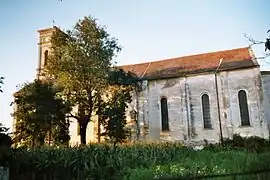Gottlob, Timiș
Gottlob (German: Gottlob; Hungarian: Kisősz) is a commune in Timiș County, Romania. It is composed of two villages, Gottlob (commune seat) and Vizejdia. These were part of the commune of Lovrin until 2004, when they were split off.[4]
Gottlob | |
|---|---|
 The Roman Catholic church in Gottlob in 2004 | |
 Location in Timiș County | |
 Gottlob Location in Romania | |
| Coordinates: 45°56′N 20°43′E | |
| Country | Romania |
| County | Timiș |
| Established | 1773 |
| Government | |
| • Mayor (2020–2024) | Gheorghe Nastor[1] (PNL) |
| Area | 39.85 km2 (15.39 sq mi) |
| Population (2021-12-01)[3] | 1,822 |
| • Density | 46/km2 (120/sq mi) |
| Time zone | EET/EEST (UTC+2/+3) |
| Postal code | 307251–307252 |
| Vehicle reg. | TM |
| Website | www |
Etymology
The commune's name is of German origin, meaning "Praise to the Lord".[5]
History
Present-day Gottlob was founded in 1773, at the same time as the neighboring village of Tomnatic, on a territory that was inhabited in the more distant past. Between 1770 and 1773, the administration, under the guidance of Chamber Councilor Hildebrand[6] (according to other sources, Captain Tribaustter),[7] would build 203 houses in Gottlob for German (Swabian) settlers. The Catholic parish was also founded in 1773. The vast majority of the settlers who founded Gottlob came from Luxembourg and Lorraine, but also from Alsace, Mainz, Trier, Franconia and a few other localities in Banat.[8]
Until 1940, Germans formed the majority of Gottlob's population. There was also a sizable French community.[9] After World War II, their numbers dropped dramatically, from about 90% to less than 10% in 1992, with a continued decline throughout that decade. In 1945, 168 Germans were deported to Russia.[7] Another 310 people were deported to Bărăgan between 1951–1956.
Demographics
Gottlob had a population of 2,041 inhabitants at the 2011 census, down 11% from the 2002 census. Most inhabitants are Romanians (86.13%), larger minorities being represented by Roma (4.07%), Germans (3.97%) and Hungarians (1.37%). For 2.89% of the population, ethnicity is unknown.[10] By religion, most inhabitants are Orthodox (71.19%), but there are also minorities of Roman Catholics (12.3%), Pentecostals (8.57%) and Baptists (3.43%). For 2.89% of the population, religious affiliation is unknown.[11]
| Census[12] | Ethnic composition | ||||
|---|---|---|---|---|---|
| Year | Population | Romanians | Hungarians | Germans | Roma |
| 1880 | 3,202 | 116 | 68 | 3,000 | – |
| 1890 | 3,223 | 111 | 20 | 3,067 | – |
| 1900 | 3,271 | 245 | 75 | 2,935 | – |
| 1910 | 2,910 | 158 | 254 | 2,403 | – |
| 1920 | 3,047 | 185 | 206 | 2,593 | – |
| 1930 | 2,625 | 107 | 38 | 2,380 | 55 |
| 1941 | 2,706 | 246 | 94 | 2,201 | – |
| 1956 | 2,993 | – | – | – | – |
| 1966 | 3,026 | 1,277 | 103 | 1,528 | 48 |
| 1977 | 2,723 | 1,259 | 84 | 1,210 | 103 |
| 1992 | 2,071 | 1,530 | 57 | 277 | 146 |
| 2002 | 2,284 | 1,885 | 44 | 171 | 130 |
| 2011 | 2,041 | 1,758 | 28 | 81 | 83 |
Economy
The main occupation of Gottlob's residents is agriculture. Gottlob is noted for its watermelon crops.[13] Cabbage, peppers, potatoes, tomatoes, cauliflower and onions are also grown.[13] The largest blueberry plantation in western Romania was established in 2014 in Vizejdia.[14]
References
- "Results of the 2020 local elections". Central Electoral Bureau. Retrieved 16 June 2021.
- "Primăria Gottlob". Ghidul Primăriilor.
- "Populaţia rezidentă după grupa de vârstă, pe județe și municipii, orașe, comune, la 1 decembrie 2021" (XLS). National Institute of Statistics.
- "Lege pentru înființarea unor comune" (PDF). Camera Deputaților.
- Crețan, Remus (2006). Dicționar toponimic și geografico-istoric al localităților din județul Timiș. Timișoara: Editura Universității de Vest. ISBN 973-7608-65-8.
- Lotreanu, Ioan (1935). Monografia Banatului. Timișoara: Institutul de Arte Grafice „Țara”. p. 202.
- Cranciova, Corina (2007). Trecut și prezent în satul bănățean. Povestea Gottlobului. O altfel de monografie. Timișoara: Brumar. pp. 14–16. ISBN 973-602-234-X.
- Möller, Karl von (1923). Wie die schwäbischen Gemeinden entstanden sind. Timișoara: Schwäbischen Verlag. p. 28.
- Németh, István (1937). "A magyarországi francia telepek" (PDF). Széphalom (9): 3–8.
- "Tab8. Populația stabilă după etnie – județe, municipii, orașe, comune". Institutul Național de Statistică. Archived from the original on 18 January 2016. Retrieved 23 October 2021.
- "Tab13. Populația stabilă după religie – județe, municipii, orașe, comune". Institutul Național de Statistică. Archived from the original on 7 August 2020. Retrieved 23 October 2021.
- Varga, E. Árpád. "Temes megye településeinek etnikai (anyanyelvi/nemzetiségi) adatai 1880-2002" (PDF).
- Both, Ștefan (26 July 2016). "Povestea celor trei pastori care cultivă lubeniță la Gottlob. Absolventul de teologie și filosofie care preferă munca în câmp". Adevărul.
- Both, Ștefan (26 March 2014). "Comuna timișeană Gottlob va deveni afinarul Europei: 11 hectare de plantație 100 la sută pentru piața externă". Adevărul.
